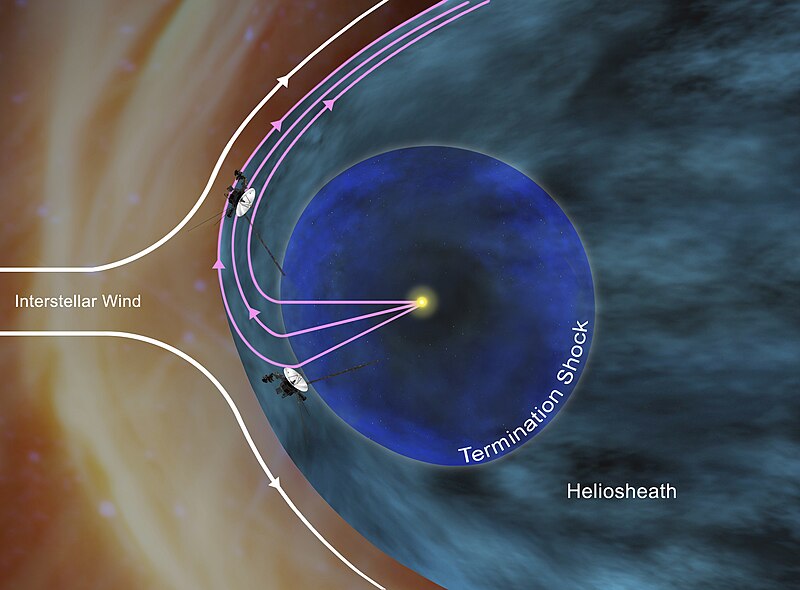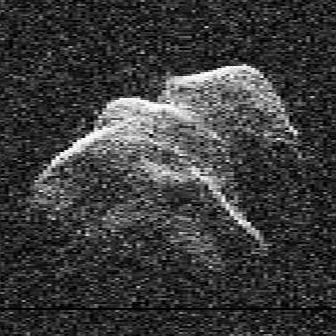Instead, we start out with a mission that began in 1977...
1. Voyager 1 Reaches Final Region of Solar System
Soon, Voyager 1 will finally exit the area of space influenced by our sun. While this is cool news, some people might be scratching their heads and wondering, "Wait, didn't it do that already? Or something similar?". The answer is of course, no. However, it's not a surprise that there's confusion on the issue. The only reason we've been able to properly determine the edge of our Solar System is through the Voyager missions, after all, so it's really up to Voyager's reports to let us know where the true edge is.
Turns out it's very close now. In 2004 Voyager 1 passed through the Termination Shock into a turbulent area of solar winds known as the heliosheath. But this past July, Voyager 1 has been sending back readings of intense magnetic fields with charged particles bouncing all over instead of a supersonic charged particle wind like it'd been experiencing in the heliosheath. However, recently it's clear that the particles are coming from both inside our heliosphere (the area of our sun's influence), and outside it. There's a new wind, so to speak. Interstellar magnetic fields are mixing in with our sun's fields.
In other words, we're almost out. There are particles from beyond our solar system getting detected by Voyager 1, and scientists suspect that within two years we'll have finally crossed over beyond our heliosphere and out into interstellar space. It's really happening, guys. We're about to leave our Solar System...
...just as we gain a better understanding of how our sun may have formed in the first place.
2. New Chemical Bonding Discovery Gives Insight Into Star Life Cycle
White dwarf stars form at the end of a star's life cycle, and are incredibly dense. Like, unbelievably dense. But how? And what does this mean for other parts of a star's life cycle?
A new answer has been proposed to explain this density. A group of scientists have created a model of an as-of-yet undescribed type of chemical bonding that works through some pretty serious magnetic fields. Fields that make anything we could create here on Earth just plain pathetic.
These magnetic fields put atoms into bonding situations we can't even hope to replicate with our current tools, so for now all experiments have been done through computer modeling. However, with this new idea in mind, astrophysicists may be able to go forth and observe this phenomena in the natural world. It's not every day you get the chance to test out the existence of a newly discovered type of chemical bonding, after all.
And in our final piece of news...
3. Okay, Yes, Another Asteroid is Coming but it is NOT BRINGING ABOUT THE APOCALYPSE
4179 Toutatis will pass by Earth on December 12th, but with a nice wide berth (over 4.3 million miles away). It's not bringing doomsday, and it is highly unlikely this asteroid ever will. So with rumors already starting regarding this space rock, this is just a reminder that seriously...the world isn't ending anytime soon.
What is exciting, is that 4179 Toutatis will give scientists a chance to study a pretty wonky space object somewhat up close. The thing is shaped almost like a peanut, and tumbles through space along its longer axis while it also precesses (or wobbles) like a top. The thing is, every time it gets close to something big, like the sun for instance, its mass shifts and its movement shifts, too. It makes for quite the challenge to study.
Its peanut shape raises load of questions about its formation. Did something smaller once hit it, messing up its shape? Did it once split apart and is now reforming back together? With the asteroid's approach this week, its these types of questions that may start to be answered. And the more questions we can answer about asteroid formation, the more we'll understand the formation of the solar system and our own planet...
...Which, by the way, isn't going to be destroyed soon. Just to make that, once again, abundantly clear. I suppose I'll have a blog post regarding that particular nonsense later this month, though, as the newest "end of the world date" draws nearer.



No comments:
Post a Comment